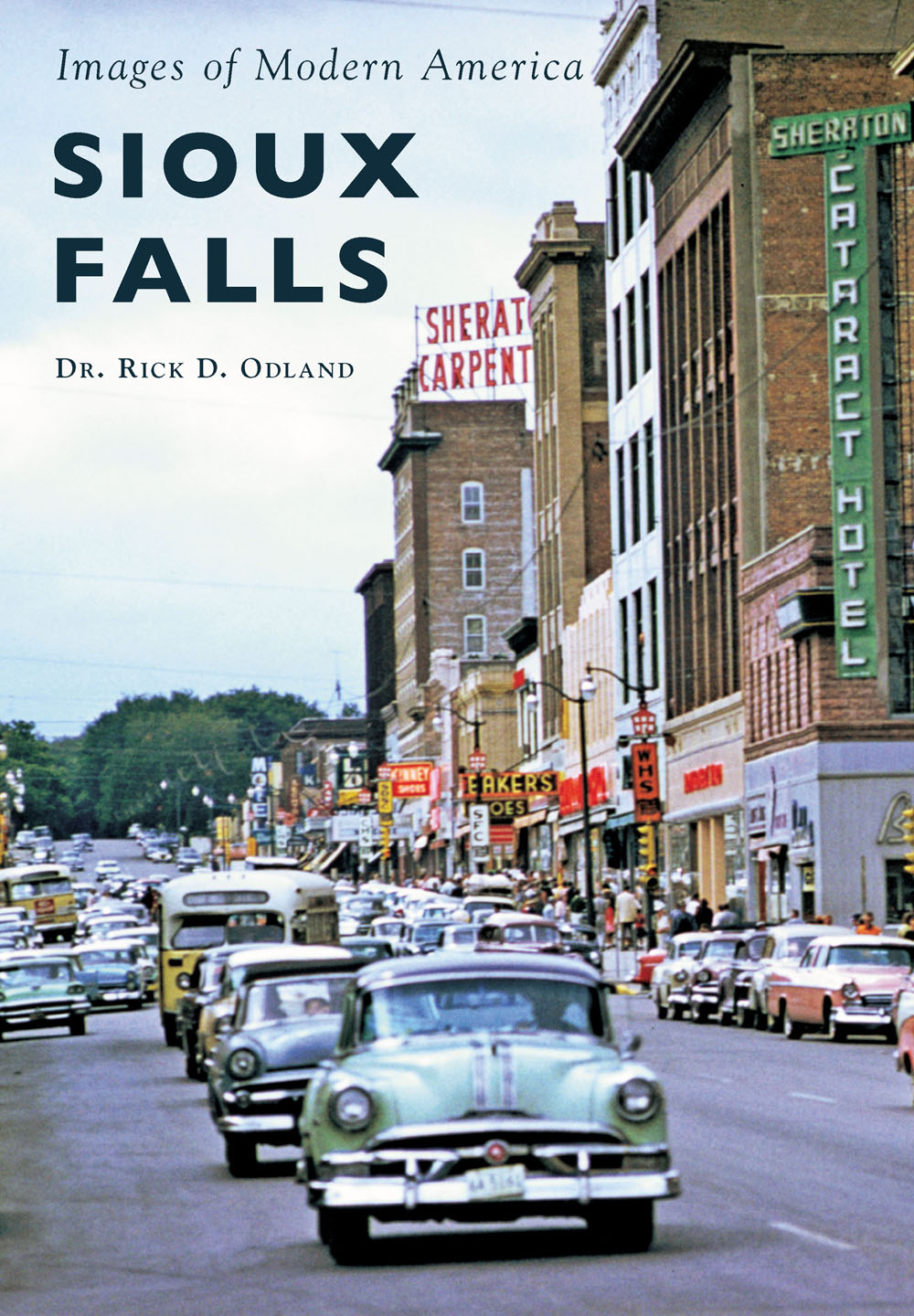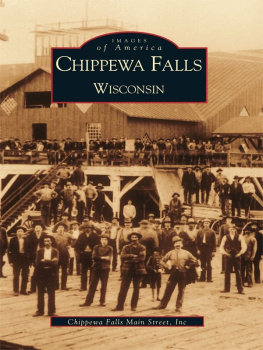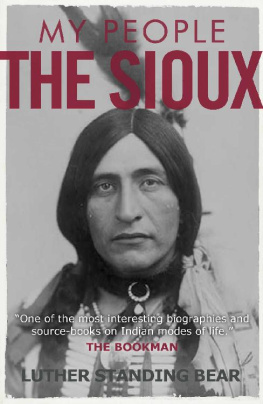
Images of Modern America
SIOUX
FALLS

One of the most defining buildings in the city has always been the Minnehaha County Courthouse. Until 1962, this building was used as a courthouse; it also housed other Minnehaha County offices. There was a period when the building sat vacant, and at one point, there was a movement to have it demolished to make space for a parking lot. In 1974, the building was officially safe from the wrecking ball and became part of the Siouxland Heritage Museums. The outside is ornately designed and built with Sioux quartzite from a local quarry. Not only is the exterior amazing, but the interior is as well. There are several large painted murals, a restored circuit courtroom, and beautiful woodwork throughout. Pioneer architect Wallace Dow designed this beautiful building, and it was constructed in 1890 with an addition completed to the north in 1937. (Authors collection.)
FRONT COVER: The cover photograph, taken in 1958, is a view of Phillips Avenue and Ninth Street looking south. The downtown area was at its peak at this time. Note the three lanes of heavy one-way traffic. Most of the buildings to the right have since been torn down. (Courtesy Charles Cushman Collection: Indiana University Archives, P10228, see .)
UPPER BACK COVER: Richard Nixon campaigning in Sioux Falls. (Authors collection, see .)
LOWER BACK COVER (from left to right): The beautiful Falls of the Big Sioux River, the namesake of Sioux Falls (authors collection); Raven Industries showing an early hot-air balloon (courtesy Orvin Olivier, see ).
Images of Modern America
SIOUX
FALLS
DR. RICK D. ODLAND

Copyright 2017 by Dr. Rick D. Odland
ISBN 978-1-4671-2690-8
Ebook ISBN 9781439661857
Published by Arcadia Publishing
Charleston, South Carolina
Library of Congress Control Number: 2017933761
For all general information, please contact Arcadia Publishing:
Telephone 843-853-2070
Fax 843-853-0044
E-mail
For customer service and orders:
Toll-Free 1-888-313-2665
Visit us on the Internet at www.arcadiapublishing.com
To Amywe share so many Sioux Falls memories together: growing up two blocks apart and going to the same elementary, junior high, high school, and college together. Thank you for supporting me while I was collecting and writing some of the memories of our Sioux Falls childhood and adult life.
ACKNOWLEDGMENTS
I am so honored to share other peoples precious pictures and delightful memories. I was welcomed around dining room tables and felt privileged to be able to hear stories about their time while living in Sioux Falls. I drove a few of you crazy trying to get the pictures I knew you hada special thanks to you. I am always amazed and greatly appreciative when building owners allow me to climb on their roofs to catch a birds-eye view of changes in the cityI may ask again.
A large percentage of the pictures in this book were shared by other people. For those pictures, I want to thank William Pay, Orvin Olivier, Merlin Sundvold, Cory Hansen, Paul and Karen Van Bockern, Olin Odland, Gary Hanson, Hubert Skip Benz, Mark Griffin, Hayley Zeigler, Jim Coppock, Joe Alick, Bob Hanson, Judy Eisenbraun, Doris and Wally Johnson, Robert Kolbe, Tom Olsen, Gerald and Patricia Bruget, Ed Limke, Jerry Wallenstein, Joe Swenson, Jim and Joan Dresch, Christian Begeman, Angie Roth, Jessica Potter, Joe Henkin, Susan (Henkin) McGowan, the Opland family, Sean Cox, Bruce Millikan, Vonita Gardner, Carl Musselman, Shelly Sjovold, Paul Farmer, Ray Campbell, Heather Howe, Wayne Prostrollo, Jay Olson, Jon Brown, Pat Marso, Brittany Christensen, Lyn Hahn, and Denise Turner. Thanks also go to the following businesses: William Pay Photography, Ideal Yardware, Lewis Drug, Cliff Avenue Greenhouse, Arthurs Shoes, Alick Drug, Harolds Photo, Pizza Inn, B&G Milky Way, Happy Joes, Vern Eide Motorcars, Bucks Muffler Shop, Handy Man, Indiana University, Clipper Jims, Parker Transfer & Storage, Christian Begeman Photography, Avera, Sanford Health, Keloland Television, Sioux Falls Jaycees, Siouxland Heritage Museums, Centurylink, Great Western Bank, Davenport Evans, and Hurwitz & Smith. Unless otherwise noted, all images appear courtesy of the author.
Thank you to Arcadia Publishing for allowing me to write this book. A special thanks to Liz Gurley at Arcadia for helping me through the process and your patience with all my questions.
A special thank you to my wife, Amy, and our children, Alex, Bekah, Sam, and Laura, for encouraging me along the way.
INTRODUCTION
This book is meant to show changes within Sioux Falls as it became a modern city and, as some would say, a metropolitan area. The years included in this book are from the 1950s to the present. This began a postwar era, and during the modern years, life for many changed dramatically. Most of the changes have been for the good of the community, but changes bring challenges as well.
Many have said the 1950s were a wonderful time. This was soon after the end of World War II. It was a slower, simpler time when neighbors acted neighborly and you could count on the neighborhood to look out for one another. Life felt secure during these times. Many people would have left their homes and cars unlocked.
Sioux Falls had a postwar population boom that lasted well into the 1960s. During World War II, Sioux Falls was home to the Army Radio Technical Training School and trained 50,000 servicemen during its three and a half years here. The school was like its own city by the airport. It was a catalyst for a boom in the population and provided stability to the local economy.
Things like pizza, television, the jukebox, and certain styles of music were relatively new. Little did anyone know then that the future would bring computers, cell phones, and advances in medicine and technology. The movie Back to the Future tried to show us the difference in culture between the years 1955 and 1985. It is staggering to think we are already another 30 years past 1985, when the movie was released.
Sioux Falls has prospered in modern times. Before the 1950s, the citys economy was largely agricultural. Since the 1950s, Sioux Falls has added other boosts to the economy with construction, credit card companies, and health care. John Morrells has continued to be a large employer, offering much to the economy since 1909. In 1981, Citibank came to Sioux Falls and added many jobs to the city. Raven Industries began in 1956 and has greatly expanded to have a worldwide impact on space exploration and environmental preservation; it is known for significantly more than just hot-air balloons. Health care has taken off in the last decade and has brought many new medical specialties and advanced medical research to Sioux Falls.
T. Denny Sanford has made history with his generosity to Sioux Falls organizations. He has given approximately $1 billion to create Sanford Health, which has greatly expanded the availability of medicine in Sioux Falls. Sanford also gave a large donation for the building of the Denny Sanford Premier Center. Since the new state-of-the art facility opened, locals and visitors alike have enjoyed concerts, sporting events, and many other forms of entertainment at the center. Prior to the Denny Sanford Premier Center, big name performers overlooked Sioux Falls due to the size of the old arena. Not only has this new venue brought entertainment, but it has helped the restaurant, hotel, and shopping industries.
Next page









